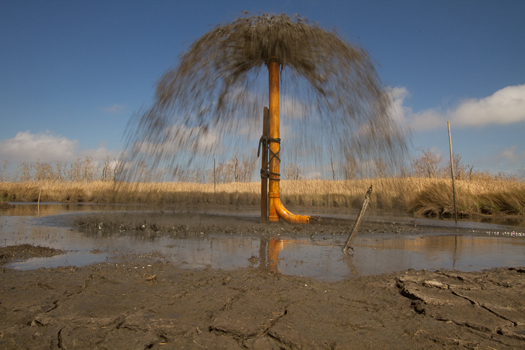
[The Audubon Society’s micro-dredger, the John James, making new land in the Paul J. Rainey Wildlife Sanctuary in South Louisiana. Karen Westphal, Audubon’s Atchafalaya Basin program manager, will be speaking about this participatory micro-dredging project at DredgeFest Louisiana’s symposium, which is this Saturday and Sunday at Loyola University in New Orleans.]
Tim Maly and I explain why we’re holding DredgeFest in Louisiana this coming weekend (and following week) for Gizmodo:
…south Louisiana is disappearing—terrifyingly fast. Sea-level rise, salt water intrusion, and canal excavation for industrial purposes have all combined with the constrainment of the river via flood control infrastructures to radically alter the balance between deposition, subsidence, and erosion. Instead of growing, the delta is now shrinking. Louisiana has lost over 1700 square miles of land (an area greater than the state of Rhode Island) since 1930. Without a change in course, it is anticipated to double that loss in the next fifty years. By 2100, subsidence, erosion, and sea level rise are projected to combine to leave New Orleans little more than an island fortress, effectively isolated in the rising Gulf of Mexico.
Moreover, even where the land itself may not be entirely submerged, the loss of barrier islands and coastal marshes exposes human settlements ever more precariously to the vicious effects of hurricanes and tropical storms, including the destructive waves known as storm surge.
This situation is entirely untenable. You thought Katrina was a terrible disaster? (It was.) Imagine what happens to New Orleans when a Category 6 hurricane hits in 2086, when even the highest ground in the French Quarter and the Garden District is barely above sea level and well below the ever-thickening barriers the Army Corps will throw up to protect America’s newest island.
In response to this apocalyptic but plausible threat, Louisiana is engaging in the world’s first large-scale experiment in restoration sedimentology. With the aid of components of the federal government like the Army Corps of Engineers and a bounty of funds earmarked for coastal restoration and protection as a result of payments owed by BP for the damages wrought by the 2010 Deep Horizon oil disaster, Louisiana has accelerated its nascent crash-program in experimental land-making machines, rapidly prototyping a wide array of weird and wonderful techno-infrastructural strategies for building land. This is an effort to cobble together a synthetic analog to the land-making machine that the Mississippi once was. If you want to understand the future of coastlines and deltas in a world of rising seas and surging storms, you should pay close attention to what is happening in Louisiana.
Read the full piece at Gizmodo. (And, if you’re able, come to DredgeFest Louisiana!)

